
| February 2002 | ||||||
| Sun | Mon | Tue | Wed | Thu | Fri | Sat |
| 1 | 2 | |||||
| 3 | 4 | 5 | 6 | 7 | 8 | 9 |
| 10 | 11 | 12 | 13 | 14 | 15 | 16 |
| 17 | 18 | 19 | 20 | 21 | 22 | 23 |
| 24 | 25 | 26 | 27 | 28 | ||
Wednesday 20 February 2002
At 1200, EST the Training Ship Empire State was located 120 nautical miles south southeast of Wilmington, NC, at 33 degrees and 03 minutes North Latitude and 075 degrees 58 minutes West Longitude, steering course 038 degrees true at a speed of 15 knots/Rpm 70 turns. The weather was cloudy, winds from the south at 5 knots, air temperature was 70 degrees Fahrenheit, barometric pressure was 1025 millibars, seas were northeasterly at 5 to 6 feet, sea injection temperature was 72 degrees Fahrenheit. Depth of water beneath the keel was 1300 fathoms.
CAPTAIN'S LOG
"I have always thought that all men should be free; but if any should be slaves, it should be first those who desire it for themselves, and secondly those who desire it for others. Whenever I hear anyone arguing for slavery, I feel a strong impulse to see it tried on him personally." --Abraham Lincoln
As we motor northerly, rolling the seasons backward from spring training in Florida to the winter Olympic weather that we left 6 weeks ago, we are finishing tasks and wrapping up efforts, counting down the days with a litany of "lasts" and lists of days left.
-Last time I do laundry on the TSES! (make a point not to sit next to this person at mess if we end up with a delay)
-Last Deck midwatch! (usually spoken by an engineer)
-Last sea term! (all 1/c and those 4/c who choose MSEP or F&EE for a major)
-Last time I share a room with 156 other men! (all 156 members of the 4/c hold)
-Only 12 more meals on steel trays! (all cadets and all Chartwells employees)
-Last time I go into the pit and come out smelling like a wet dog parboiled in diesel oil! (Deck, MSEP, IMB, F&EE cadets)
-Only 4 and a wake up until I sleep in my own bed (all hands)
One "last" of this sea term happens today: the last fire and boat drill.
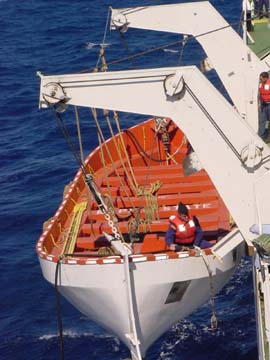
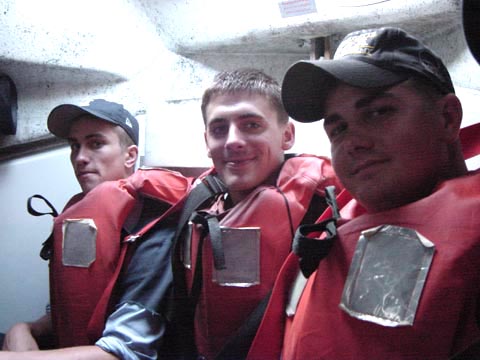
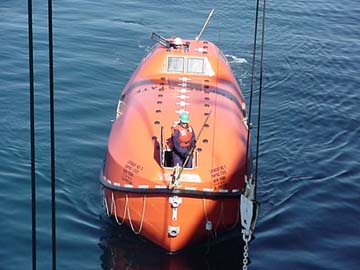
Every Wednesday for the last 6 weeks we have run these drills to indoctrinate all cadets on the proper procedures for a shipboard evacuation into lifeboats. Cadets in all three divisions rotate through the various lifeboat launching and recovery positions until they are so familiar with the steps they can recite them in their sleep (or in a horrible crisis with the wind screaming in their ears and their hearts in their throats).
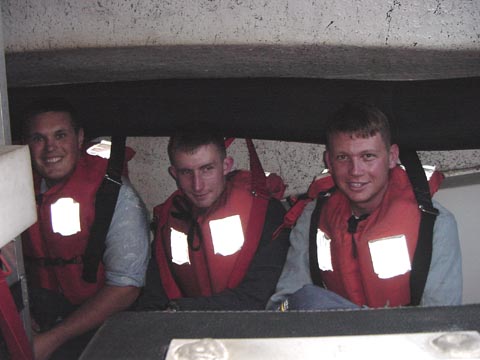
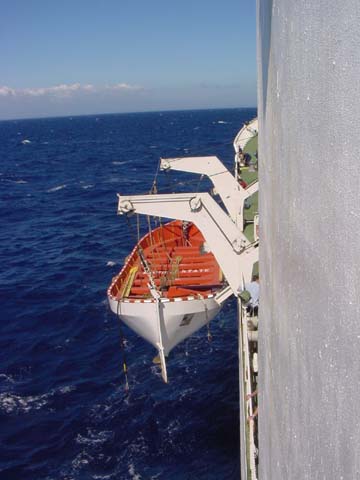
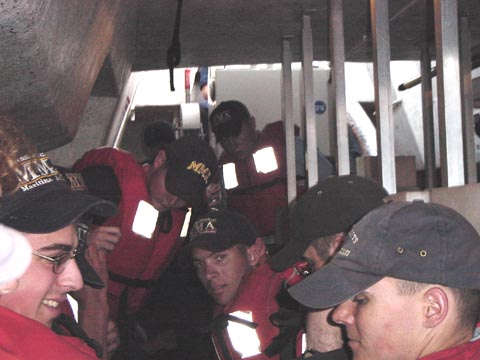
But each drill has also served to keep our crack shipboard fire team in top condition to respond to a fire emergency anywhere onboard. We start each drill with a simulated fire in a different part of the ship and regardless of how well the fire party does on fighting the fire, we progress to "Abandon ship!". As a result, I think everyone on board must be convinced that these fire fighters are hopeless incompetents and one better sleep with their lifejacket on because "abandon ship" looks like it is a naturally occurring event that follows whenever a fire is reported.
In fact, the Shipboard Fire Party is a team of true experts. Composed of some of of top people on the ship, they are volunteers who receive special training in shipboard fire fighting- over and above the rigorous training given to all cadets. They have their own break out gear (firefighter clothes) and are organized into hose teams and search and rescue teams. Like volunteer firefighters in a rural community, they give of themselves so that others can work and sleep in the comfort of safety. Every Wednesday, at 1600, the end of the "normal" work day, I begin a F&B (or Hook-n-ladder or F-in boat) drill. The ship's whistle and general alarm will sound continuously for more than 10 seconds, and most aboard will just report to their lifeboat muster station, wait to be mustered and wait for the drill to end. The fire party, however, rushes from their various locations through out the vessel, grabs their gear, reports to the scene of the "emergency" and suits up. For the next hour, in the heat and humidity of the tropics, crawling up and down ladders with 50 pounds of equipment strapped to their backs while dragging charged hoses, they fight the fire. They set fire boundaries, secure ventilation or electrical power and evacuate casualties. They change air tanks on fellow team members if the drill drags on too long, but they keep at it until the Chief Mate calls the team off, radios the bridge that the "fire is out of control" and I proceed to the abandon ship portion of the afternoon's training session.
As we celebrate the last F&B drill of sea term 2002, I wanted to thank all those brave firefighters aboard who stepped up to put themselves on the point of the spear if we ever needed them to fight a fire aboard this ship. THANK YOU ALL. We do appreciate your efforts.
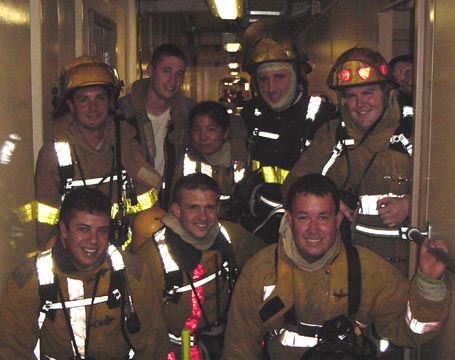
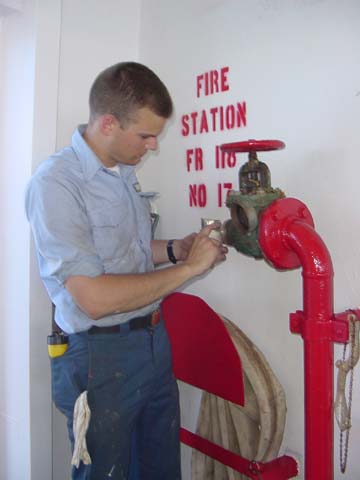
CADET'S COMMENT
by 1/C Caryn Arnold
Last night was casino night, set up by the Student Government Association (SGA). Even though some of the equipment was missing (or I should say forgotten) the night went well. Stations were set up around the mess deck where you could play black jack, poker or bingo. The SGA Cadets were the dealers and some even got the chance to play. Each cadet that participated received 20 paper dollars to start. If they wanted any more, then they would have to pay a real dollar. The prizes that were given out included: First Cadet off the ship in Buzzards Bay, the chance to sit in Captain's chair during the Canal transit this Sunday, the chance to be the Regimental Commander at Morning Formation, one Friday sign-out off, one Wednesday morning inspection off, a gift certificate to Olive Garden, a gift certificate to the Ship's Store (on campus), a Gas card, a Blockbuster card, a case of Soda, a disposable camera, 2- $20, 2 nacho's & cheese dishes (from the snack bar), and even Breakfast in Bed served by Lieutenant Commander Rozak, the Assistant Commandant. Win or lose, we all had a great time... and it helped kill time. Three and a wake up!
QUESTIONS FOR THURSDAY 21 FEBRUARY 2002
MATH: The Navigator informed the Cadet Officer of the Watch that the earth is approximately 8,000 miles in diameter and asked her how far they would travel if they circumnavigate the earth at the equator. Approximately, how far is it?
SCIENCE: The Food services crew is also concerned with waves, very high frequency waves. These waves transfer energy to water molecules inside popcorn kernels, causing them to vibrate faster and faster. What are these waves called?
GEOGRAPHY: There was a well-known port on the island of Jamaica where many pirates took their prizes to be evaluated and sold. The city was a place where people lived " a wild and reckless life." It was called " one of the wickedest places on earth. Something happened to this port city at about 20 minutes before twelve on the morning of the seventh of June 1692. What was the name of the port? What happened? What was the result?
HISTORY: The 1950's and 1960's were difficult years for the United States and its neighbor Cuba. After Cuba accepted a socialist system in 1959, a group of Cubans who fled from their homeland attempted to invade Cuba, with the assistance of the United States and other nations, hoping to start a new revolution against the socialist government. Who was the President of the United States when the invasion was attempted on April 17, 1961? Where did the invasion take place? What was the result?
ANSWERS FOR WEDNESDAY 20 FEBRUARY 2002
MATH: C = pi x d C = circumference Pi = 3.1416 or 22/7 r = radius or (21 nautical miles) d = 2 x r C = pi x d C = 22/7 x 42 C = 132 nautical miles
SCIENCE: Decibels (dB). The decibel scale is used to measure the intensity (loudness) of sound.
GEOGRAPHY: A cape is a point of land that extends into the sea. A peninsula is different from a cape because a peninsula extends further into the sea than a cape.
HISTORY: Blackbeard's ship was called the Queen Anne's Revenge. She was a captured French slave ship (the Concorde) that he converted for his own use.